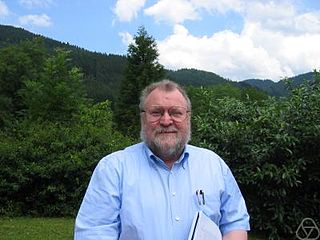Related Research Articles
Control theory is a field of control engineering and applied mathematics that deals with the control of dynamical systems in engineered processes and machines. The objective is to develop a model or algorithm governing the application of system inputs to drive the system to a desired state, while minimizing any delay, overshoot, or steady-state error and ensuring a level of control stability; often with the aim to achieve a degree of optimality.

In mathematics, a dynamical system is a system in which a function describes the time dependence of a point in an ambient space, such as in a parametric curve. Examples include the mathematical models that describe the swinging of a clock pendulum, the flow of water in a pipe, the random motion of particles in the air, and the number of fish each springtime in a lake. The most general definition unifies several concepts in mathematics such as ordinary differential equations and ergodic theory by allowing different choices of the space and how time is measured. Time can be measured by integers, by real or complex numbers or can be a more general algebraic object, losing the memory of its physical origin, and the space may be a manifold or simply a set, without the need of a smooth space-time structure defined on it.
Harmonic analysis is a branch of mathematics concerned with investigating the connections between a function and its representation in frequency. The frequency representation is found by using the Fourier transform for functions on the real line or by Fourier series for periodic functions. Generalizing these transforms to other domains is generally called Fourier analysis, although the term is sometimes used interchangeably with harmonic analysis. Harmonic Analysis has become a vast subject with applications in areas as diverse as number theory, representation theory, signal processing, quantum mechanics, tidal analysis and neuroscience.

In mathematics, the Lyapunov exponent or Lyapunov characteristic exponent of a dynamical system is a quantity that characterizes the rate of separation of infinitesimally close trajectories. Quantitatively, two trajectories in phase space with initial separation vector diverge at a rate given by
A dissipative system is a thermodynamically open system which is operating out of, and often far from, thermodynamic equilibrium in an environment with which it exchanges energy and matter. A tornado may be thought of as a dissipative system. Dissipative systems stand in contrast to conservative systems.
Ergodic theory is a branch of mathematics that studies statistical properties of deterministic dynamical systems; it is the study of ergodicity. In this context, "statistical properties" refers to properties which are expressed through the behavior of time averages of various functions along trajectories of dynamical systems. The notion of deterministic dynamical systems assumes that the equations determining the dynamics do not contain any random perturbations, noise, etc. Thus, the statistics with which we are concerned are properties of the dynamics.
Noncommutative geometry (NCG) is a branch of mathematics concerned with a geometric approach to noncommutative algebras, and with the construction of spaces that are locally presented by noncommutative algebras of functions, possibly in some generalized sense. A noncommutative algebra is an associative algebra in which the multiplication is not commutative, that is, for which does not always equal ; or more generally an algebraic structure in which one of the principal binary operations is not commutative; one also allows additional structures, e.g. topology or norm, to be possibly carried by the noncommutative algebra of functions.
In mathematics, an amenable group is a locally compact topological group G carrying a kind of averaging operation on bounded functions that is invariant under translation by group elements. The original definition, in terms of a finitely additive measure on subsets of G, was introduced by John von Neumann in 1929 under the German name "messbar" in response to the Banach–Tarski paradox. In 1949 Mahlon M. Day introduced the English translation "amenable", apparently as a pun on "mean".
In mathematics, integrability is a property of certain dynamical systems. While there are several distinct formal definitions, informally speaking, an integrable system is a dynamical system with sufficiently many conserved quantities, or first integrals that its motion is confined to a submanifold of much smaller dimensionality than that of its phase space.
In mathematics, the Poincaré–Bendixson theorem is a statement about the long-term behaviour of orbits of continuous dynamical systems on the plane, cylinder, or two-sphere.
Floquet theory is a branch of the theory of ordinary differential equations relating to the class of solutions to periodic linear differential equations of the form
Nonlinear control theory is the area of control theory which deals with systems that are nonlinear, time-variant, or both. Control theory is an interdisciplinary branch of engineering and mathematics that is concerned with the behavior of dynamical systems with inputs, and how to modify the output by changes in the input using feedback, feedforward, or signal filtering. The system to be controlled is called the "plant". One way to make the output of a system follow a desired reference signal is to compare the output of the plant to the desired output, and provide feedback to the plant to modify the output to bring it closer to the desired output.
In the mathematics of evolving systems, the concept of a center manifold was originally developed to determine stability of degenerate equilibria. Subsequently, the concept of center manifolds was realised to be fundamental to mathematical modelling.
In mathematics, a conservative system is a dynamical system which stands in contrast to a dissipative system. Roughly speaking, such systems have no friction or other mechanism to dissipate the dynamics, and thus, their phase space does not shrink over time. Precisely speaking, they are those dynamical systems that have a null wandering set: under time evolution, no portion of the phase space ever "wanders away", never to be returned to or revisited. Alternately, conservative systems are those to which the Poincaré recurrence theorem applies. An important special case of conservative systems are the measure-preserving dynamical systems.
Arithmetic dynamics is a field that amalgamates two areas of mathematics, dynamical systems and number theory. Part of the inspiration comes from complex dynamics, the study of the iteration of self-maps of the complex plane or other complex algebraic varieties. Arithmetic dynamics is the study of the number-theoretic properties of integer, rational, p-adic, or algebraic points under repeated application of a polynomial or rational function. A fundamental goal is to describe arithmetic properties in terms of underlying geometric structures.
In dynamical systems theory, Conley index theory, named after Charles Conley, analyzes topological structure of invariant sets of diffeomorphisms and of smooth flows. It is a far-reaching generalization of the Hopf index theorem that predicts existence of fixed points of a flow inside a planar region in terms of information about its behavior on the boundary. Conley's theory is related to Morse theory, which describes the topological structure of a closed manifold by means of a nondegenerate gradient vector field. It has an enormous range of applications to the study of dynamics, including existence of periodic orbits in Hamiltonian systems and travelling wave solutions for partial differential equations, structure of global attractors for reaction–diffusion equations and delay differential equations, proof of chaotic behavior in dynamical systems, and bifurcation theory. Conley index theory formed the basis for development of Floer homology.

Eduard J. Zehnder is a Swiss mathematician, considered one of the founders of symplectic topology.

Time-translation symmetry or temporal translation symmetry (TTS) is a mathematical transformation in physics that moves the times of events through a common interval. Time-translation symmetry is the law that the laws of physics are unchanged under such a transformation. Time-translation symmetry is a rigorous way to formulate the idea that the laws of physics are the same throughout history. Time-translation symmetry is closely connected, via Noether's theorem, to conservation of energy. In mathematics, the set of all time translations on a given system form a Lie group.
A barrier certificate or barrier function is used to prove that a given region is forward invariant for a given ordinary differential equation or hybrid dynamical system. That is, a barrier function can be used to show that if a solution starts in a given set, then it cannot leave that set.
References
- ↑ Conley, Charles (1978). Isolated invariant sets and the morse index: expository lectures. Regional conference series in mathematics. National Science Foundation. Providence, RI: American Mathematical Society. ISBN 978-0-8218-1688-2.
- ↑ Norton, Douglas E. (1995). "The fundamental theorem of dynamical systems". Commentationes Mathematicae Universitatis Carolinae. 36 (3): 585–597. ISSN 0010-2628.
- ↑ Razvan, M. R. (2004). "On Conley's fundamental theorem of dynamical systems". International Journal of Mathematics and Mathematical Sciences. 2004 (26): 1397–1401. arXiv: math/0009184 . doi: 10.1155/S0161171204202125 . ISSN 0161-1712.
- ↑ Hurley, Mike (1991). "Chain recurrence and attraction in non-compact spaces". Ergodic Theory and Dynamical Systems. 11 (4): 709–729. doi:10.1017/S014338570000643X. ISSN 0143-3857.
- ↑ Kvalheim, Matthew D.; Gustafson, Paul; Koditschek, Daniel E. (2021). "Conley's Fundamental Theorem for a Class of Hybrid Systems". SIAM Journal on Applied Dynamical Systems. 20 (2): 784–825. arXiv: 2005.03217 . doi:10.1137/20M1336576. ISSN 1536-0040.
- ↑ Hafstein, Sigurdur; Giesl, Peter (2015). "Review on computational methods for Lyapunov functions". Discrete and Continuous Dynamical Systems - Series B. 20 (8): 2291–2331. doi: 10.3934/dcdsb.2015.20.2291 . ISSN 1531-3492.